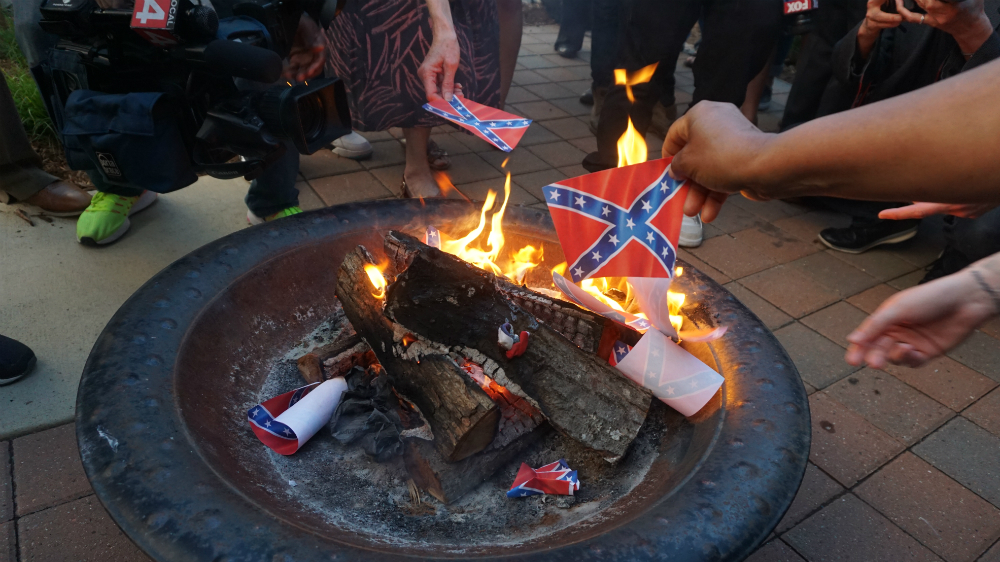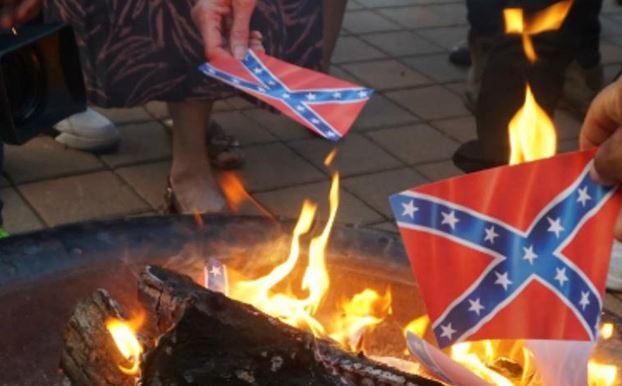MICHIGAN: Activists Gather to Burn Confederate Flag
DETROIT — By Memorial Day evening, after the parades had passed and most of the smoke from barbecues and fireworks had lifted from neighbourhoods across the United States, activists in Detroit were just starting their flag burning.
John Sims held a folded Confederate flag and placed it gently into a pit of flames.
“Amen! Yes!” spectators responded.
A crowd of people, young and old, black and white, fixed their eyes on the burning nylon as it curled inward, sending up trails of oily smoke. After the reds, whites and blues had blackened, they approached with their own Confederate tinder, tossing paper flag after paper flag into the pit.
The cremation of the Confederate flag ended. Funeral Director John Sims led the not-so-bereaved back inside, where a hip-hop remix of the southern anthem “Dixie” kicked off the after party. The jovial gatherers mingled and toasted to the death of a divisive symbol as old as the country.
 |
| More than 70 people attended the Confederate flag burning held at the N’Namdi Center for Contemporary Art in Detroit on Memorial Day [Kurt Nagl/Al Jazeera] |
It was part of an artistic performance Sims, 49, started 15 years ago, a symbolic banishing of the Confederate flag that has grown more radical, he said, with each injustice suffered by the black community.
“We are de-zombifying the flag,” he said before the ceremony. “The flag should have died with the soldiers on the battlefield.”
Making such a controversial statement is certainly in keeping with the American spirit of free speech. But this was Memorial Day – a 150-year-old national holiday in remembrance of soldiers fallen in service to the country – in Detroit, ground zero of racial tensions that 50 years ago this summer spilled over into one of the deadliest riots in the country’s history.
Sims stands a towering 6’5″ (196cm), plus a few inches of unkempt afro. He wears black-rimmed glasses, and his voice carries like a preacher’s.
“This is a time to think about what the Civil War really means and how the flag, after the war, was coopted by the Ku Klux Klan and turned into a symbol of terrorism and intimidation,” Sims said. “We’re drawing strength from the protest energy of Detroit … and the pride and capacity of its people to speak up and respond actionably.”
READ MORE: Should New Orleans remove its statue of Robert E Lee?
He grew up not far from the site of his latest demonstration, the N’Namdi Center for Contemporary Art, which is a few minutes from Rosa Parks Boulevard and Clairmount Avenue, where the 1967 riots broke out.
This was the first time Sims burned the flag in his hometown, a city with the highest concentration of African Americans in the country, according to 2010 census data. While Confederate flags are rare in the area, they can sometimes be spotted on car bumpers or fluttering in the occasional rural front yard. (Since flags can be hard to find in some areas, Sims added to his website (burnandbury.org) downloadable “support kits,” or paper flags that can be printed and burned.)
To be clear, Sims’ demonstrations have never been a call to arms, though can seem antagonistic in nature. They have always been about encouraging discourse, he said, and a source of therapy for black people scared of the flag or looking for closure.
Sims started the ceremony with a recitation of his poem “A Blazing Grace,” which begins, “How bitter the taste – of a wretched past – how dark the spirit – of a lost heart and mind.”
More than 70 people attended the mock funeral, and a host of locally acclaimed poets and activists performed in front of the flag laying “in rest” before them.
“We’ve come here today to put to rest a symbol that’s long passed its time,” said Jeff Nelson, a pastor and slam poet.
WATCH: Confederate flag supporters rally in US state
Poet Kim Hunter took up the podium next and asked the audience, “Ya’ll ready to burn some stuff?” He then recited a poem titled “Dicksee”, a play on “Dixie.”
Any hostility in the room was directed towards the flag. Sims has not always been so lucky. The activist has been ridiculed and threatened with death because of his work.
In one of his first protests with the flag, he recoloured it green, black and red – colours of the Pan-African flag – and waved it at a KKK rally down south. The white supremacy group responded by issuing a statement calling him – inaccurately – a racist homosexual and denouncing the desecration of a “symbol of white Christian America”.
He even lynched the flag in Gettysburg, much to the dismay of the Sons of Confederate Veterans, a band of prideful men genealogically connected to the Confederacy.
 |
| After a Confederate flag burning held at the N’Namdi Center for Contemporary Art in Detroit on Memorial Day, audience members placed their own paper flags into the fire [Kurt Nagl/Al Jazeera] |
After white supremacist Dylann Roof murdered nine black people in a Charleston, South Carolina, church, Sims issued an edict for 13 southern states to bury the flag.
Just over the weekend in Portland, Oregon, a man known to authorities as a white supremacist was accused of killing two people who stood up to his racial intimidation of women.
Sims, therefore, believes his message is more urgent than ever and any blowback he receives only stokes the fire of resistance by putting “extremists on the defensive”, he said. He has no illusions that the flag will disappear, just like he has no intentions to stop burning it.
“It is a permanent part of American history, so it’s important to have counterbalancing rituals that point to the history of racist attitudes in the country,” he said.
READ MORE: A history of American lynchings
Ryan Spencer, general manager of Greenfield Village, a history museum complex that produces an annual Civil War re-enactment of more than 780 participants, said to have a grasp on the country’s history, its full story must be told. As such, the Confederate flag is used at the museum in an educational context.
“Civil War remembrance comes from a place of mourning, and the country is still trying to come to terms with what happened – the good and the bad,” Spencer said. “Difficult history is still history. We can’t just forget.”
Sims said he wants to keep the Memorial Day funeral of the Confederate flag an annual tradition, as a reminder of the ugly things the flag has represented.
“I hope the fabric of humanity can mend itself,” said activist Monica Lewis-Patrick, “so that it makes something far more superior than this flag ever stood for.



